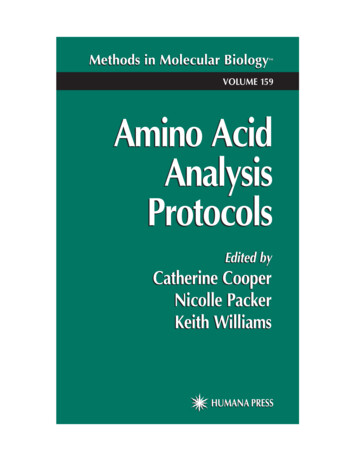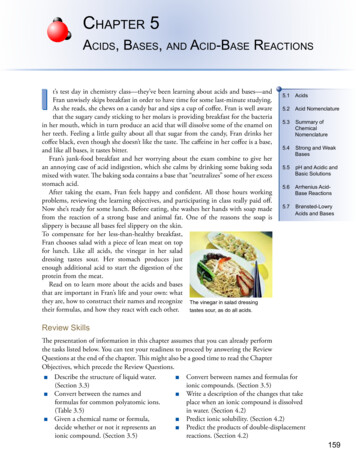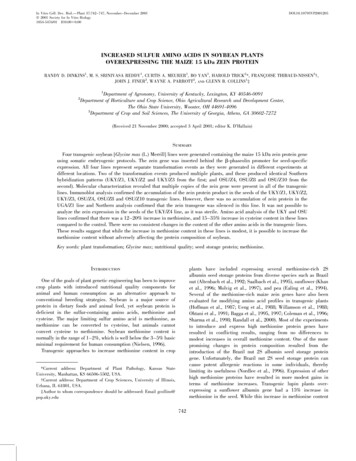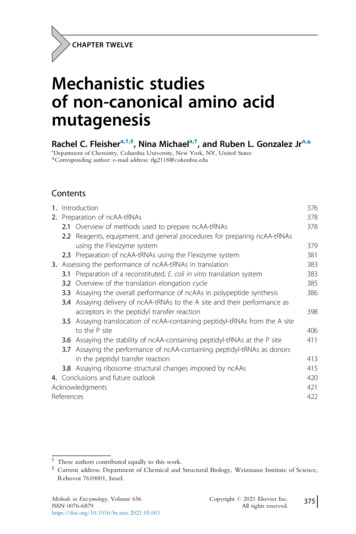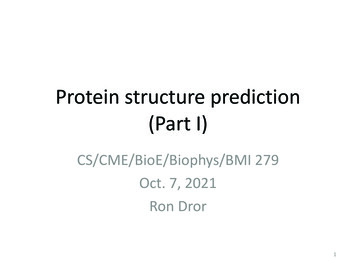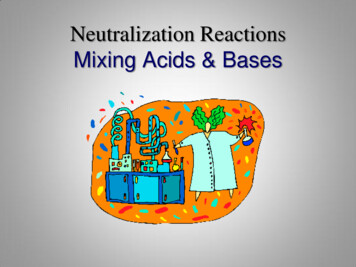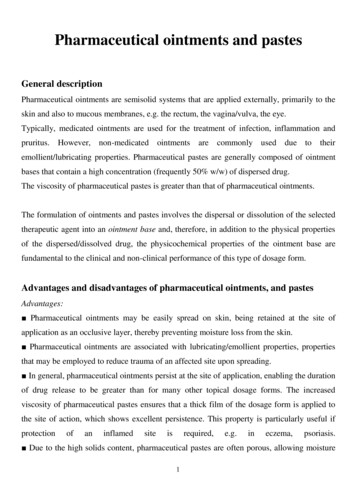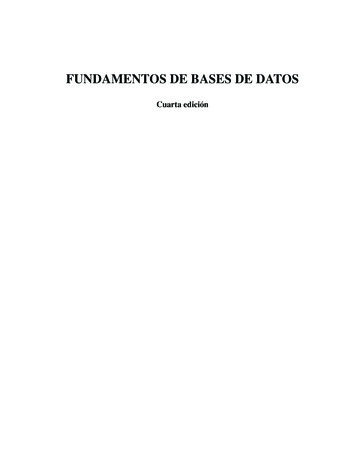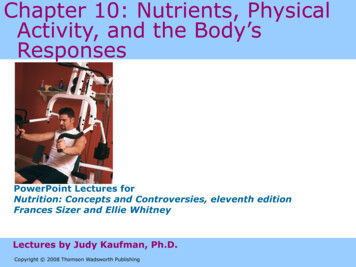
Transcription
CHM333 LECTURES 7 & 8: 1/28 – 30/12SPRING 2013Professor Christine HrycynaAmino Acids as Acids, Bases and Buffers:--Amino acids are weak acidsAll have at least 2 titratable protons(shown below as fully protonated species)and therefore have 2 pKa’so α-carboxyl (-COOH)o α-amino (-NH3 )Some amino acids have a third titratableproton in the R group and therefore a thirdpKao Showing all protonated:Histidine side chain ionizationImidazolium ion (an acid):44
CHM333 LECTURES 7 & 8: 1/28 – 30/12SPRING 2013Professor Christine HrycynapKa Table for amino acids:* First column (pKa1) COOH* Second column (pKa2) NH3 * Third column (pKaR) R group H AMINO ACIDS AS WEAK ACIDS:- Properties of amino acids in proteins and peptides are determined by the Rgroup but also by the charges of the titratable group. Will ultimately affectprotein structure.- Important to know which groups on peptides and proteins will be protonatedat a certain pH.The degree of dissociation depends on thepH of the solution.45
CHM333 LECTURES 7 & 8: 1/28 – 30/12SPRING 2013Professor Christine HrycynaHGlycineH The first dissociation is the carboxylic acidgroup (using glycine as an example): NH3CH2COOH!" NH3CH2COO- H [ NH3CH2COO-][H ]Ka1 --------------------------[ NH3CH2COOH] The second dissociation is the amino group inthe case of glycine: NH3CH2COO!" NH2CH2COO- H [NH2CH2COO-][H ]Ka2 --------------------------[ NH3CH2COO-]How do we do this?Example – Alanine1.2.Draw the fully protonated structureQ: Which protons come off when?A: Look at pKa table for amino acidsAlanine has 2 pKas:α-COOH (pKa 2.3) comes off first (has lower pKa)α-NH3 (pKa 9.9)Others come off SEQUENTIALLY in ascending order of pKa.Write out structures for sequential deprotonation and place pKa values over theequilibrium arrows.AlanineFully protonatedNet charge 11st proton removedNet charge 02nd proton removedNet charge -146
CHM333 LECTURES 7 & 8: 1/28 – 30/12SPRING 2013Professor Christine HrycynaSo, from looking at the net charges, at different pH’s, amino acids can have different charges!Very important for protein structure!!Remember that the pKa pH when ½ of an available amount of an ionizable group is ionized.- Let’s take a look at the titrationcurve for Alanine- Looks very much like what wesaw for acetic acid last time except thatit has 2 midpoints (pKa’s) – one foreach proton α-COOH and α-NH3 --At beginning, all protonatedNeed one equivalent of base for eachprotonAt each HALF equivalent pKao 50% protonated/50%deprotonatedAt end all deprotonated-Flat parts of curve are BUFFERING REGIONS: Acts as buffer in TWO pH ranges.o /- 1 pH unit from pKa-For our purposes, to determine whether the proton is ON or OFF at a certain pH use thefollowing RULESo pH pKaEqual amounts of protonated and deprotonated species existif pH is LESS than the pKa of a particular group, thatgroup will be predominantly protonatedif pH is GREATER than the pKa of a particular ionizablegroup, that group will be predominantly deprotonatedFor example: Alanine at different pH’s (see pKa table)At pH 1.5:pH is less than the pKa of both the α-COOHand the α-NH3 , therefore, both protons are ONAt pH 7:pH is greater than the pKa of the α-COOH à H OFFpH is less than the pKa of the α-NH3 à H ON47
CHM333 LECTURES 7 & 8: 1/28 – 30/12At pH 10.5SPRING 2013Professor Christine HrycynapH is greater than the pKa of the α-COOH à H OFFpH is greater than the pKa of the α-COOH à H OFFApply same rules if there are 3 titratable protons:1.Determine what the pKa’s of the titratable protons are by looking at the pKa table2.Draw the structures and the equilibria representing the complete deprotonation of theamino acida. Start with fully protonated and then remove in order of pKa valuesb. Put pKa values above equilibrium3.Determine at the pH of interest whether the proton is ON or OFF using the above rulesFor example, Aspartate (D, Asp): Asp has 3 titratable protons1. pKa’s for the three groups (look at Table3.2)2. Draw the structures from fully protonated to fully deprotonated48
CHM333 LECTURES 7 & 8: 1/28 – 30/12SPRING 2013Professor Christine HrycynaNote that all amino acids are at one point, electrically neutral at some pH value.This pH isoelectric point (pI)How do you calculate pI?1. Draw out the complete ionization of amino acid2. Determine net charge on each ionized form3. Find the structure that has no net charge4. Take the average of the pKa’s that are around the structure with NO NET CHARGEpI pKa1 pKa225. Note do NOT just take the average of all pKa’s.What about Asp? pKas: 2, 3.9, 10 (from Table 3.2)pI (2 3.9)/2 2.95Amino acids can be separated on the basis of their charges at a certain pHHOW ARE AMINO ACIDS MADE?----Many organisms can make all 20 of the aminoacidso Bacteria, yeast, and plantsSome amino acids are made from commonmetabolic intermediates directlyo For example, alanine is made from pyruvate(transamination of pyruvate with glutamateas the amino donor)Some amino acids are made as products from longand complex pathwayso For example, aromatic amino acids aremade from the shikimic acid pathwayHumans and other animals CANNOT make someof the 20 amino acidso These are ESSENTIAL AMINO ACIDSArginine and Histidine are essential only inbabies or in people with extreme metabolic stressdisease – Conditional Essential Amino Acids- Foods vary in “protein quality”o Content of essential amino acids49
CHM333 LECTURES 7 & 8: 1/28 – 30/12§ § SPRING 2013Professor Christine Hrycyna- Animal proteins are often of a “higher quality” than vegetableproteinso Cereals are deficient in Lyso Legumes are low in Met and Cyso So vegetarians need variety- Since human cannot make all 20 aa’s – we aresusceptible to protein malnutrition especially inchildren and elderly adults- Disorder called Kwashiorkor§ Protein disorder in children§ Prevalent in overpopulated areas, particularly sections ofAfrica, Central & South America, and South Asia§ Areas of famine, limited food supply, diet mainlyconsisting of starchy vegetables§ Diet is adequate in calories (energy) but deficient in aminoacidsSymptoms include: lethargy, irritability, protruding belly, changes in skin pigment, hair changes,increased infectionsdue to damaged immune system, enlarged liver, renal problems.Treatment: Depends on severityIncrease calories from proteins usually in form of dry milkIf not treated soon enough, permanent physical and intellectual disabilities can resultHOW CAN WE EXPLOIT THE FACT THAT WE HAVE ESSENTIAL AMINO ACIDS?EXAMPLE: Use in agriculture:-Pathways leading to essential amino acids aregood targets for herbicides-Glyphosate (RoundUp) (Nphosphonomethyl-glycine)-o Inhibitor of EPSP synthase, anenzyme in the shikimic acid pathwayo Blocks the production of aromaticamino acidso Non-selective killer of anything green!Glyphosate is relatively non-toxic to humans because we do NOT make our own aromaticamino acids.-RoundUp Ready soybeans and cotton carry an altered gene for EPSP synthase – introduced intothe plants using biotechnology-Altered gene encodes a protein that resists the RoundUp inhibitor50
CHM333 LECTURES 7 & 8: 1/28 – 30/12SPRING 2013Professor Christine HrycynaPEPTIDES and PROTEINS---Learned basic chemistry of amino acids – structure and chargesChemical nature/charges of amino acids is CRUCIAL to the structure and function ofproteinsAmino acids can assemble into chains (peptides, polypeptides, proteins)o Can be very short to very long§ Dipeptide two amino acids linked§ Tripeptide three amino acids linkedAmino acids sometimes called RESIDUESIdentity and function of a protein or peptide is determined byo Amino acid compositiono Order of amino acids in the chaino Enormous variety of possible sequences§ e.g., if you have a protein with 100 aa, there are 1.27 X 10130 possiblesequences!Amino acids are linked by COVALENT BONDS PEPTIDE BONDSPeptide bond is an amide linkage formed by a condensation reaction (loss of water)Brings together the alpha-carboxyl of one amino acid with the alpha-amino of anotherPortion of the AA left in the peptide is termed the amino acid RESIDUEo Amino acids sometimes called RESIDUESR groups remain UNCHANGED – remain activeN-terminal amino and C-terminal carboxyl are also available for further reactionReaction is NOT thermodynamically favorable (not spontaneous)o Need energy and other components and instructions to correctly assemble§ This is the process of protein translationFORMATION OF THE PEPTIDEBOND51
CHM333 LECTURES 7 & 8: 1/28 – 30/12SPRING 2013Professor Christine HrycynaAnimation of peptide bond ects/ViewObject.aspx?ID BIC007-Peptides are always written in the N à C directionEach peptide has ONLY ONE free amino group and ONE free carboxyl group; others areneutralized by formation of the peptide bondIMPORTANT FEATURES OF THE PEPTIDE BOND:1.Peptide bonds have double bond character resulting from resonance stabilization(C-N bond has 40% double bond character) C-N and C-O have partial double bond characterResonance Results in Partial Double Bond Character ofthe Peptide Bond (Amide Bond):Rotation Restricted52
CHM333 LECTURES 7 & 8: 1/28 – 30/12SPRING 2013-Results in the peptide bond being PLANARo C, N, H, O are all in the same plane(Cα’s are also in plane)o p orbitals can overlap to form partialdouble bonds between the nitrogenand carbon and the carbon andoxygen-Stronger than a normal bond because of thedouble bond characterNo tendency to protonateNo significant rotation occurs around the peptide bond itself.PEPTIDE BACKBONE ismade up of these rigid planarunits with limited rotationaround the Cα carbons – NCα1 (phi) and the Cα2 C (psi)bonds. These bonds link thepeptide groups in the peptidechaino Crucial for proteinstructureo Rotation can occur at theα carbonso However, rotation islimited due to sterichindrance (R groups)o These limitations limitthe shapes that can beassumed by proteinchains-Professor Christine Hrycyna53
CHM333 LECTURES 7 & 8: 1/28 – 30/12SPRING 2013Professor Christine HrycynaThese limitations force Cα carbons on either side of the peptide bond to be, with fewexceptions, trans to each other (opposite sides of the peptide bond)a.Cis configuration is rare; steric hindrance is greaterb.Trans is much more stable (sterically favored)c.R-groups (on the Cα carbons) also end up on opposite sides of the peptide bondi.(R-groups away from each other – favored)ALMOST EXCLUSIVELY TRANS CONFIGURATIONSUMMARY:1. Cα, O, C, N and H atoms are planar2. No rotation around the peptide bond3. Cα (with R groups) groups are in trans configuration (i.e. H on the amideNitrogen is opposite to the Oxygen of the carbonyl)4. Peptide backbone is rigid54
CHM333 LECTURES 7 & 8: 1/28 – 30/12SPRING 2013Professor Christine HrycynaDRAWING PEPTIDES GIVEN THEIR AMINO ACID SEQUENCE:1)Peptide ALDSLeft à Right N à C-terminus (amino to carboxyl termini)Want to draw it at pH 5Draw the PEPTIDE BACKBONE fully protonated for as many amino acids as you have. Forconvenience, convention and ease, put the R groups down and the carbonyls up.In our case, we have FOUR amino acids:55
CHM333 LECTURES 7 & 8: 1/28 – 30/12SPRING 2013Professor Christine Hrycyna2.Add in the side chains onto the Cα carbons – the ones that have the CH group – inorder left to right. Draw side chains fully protonated as well.3.Determine if groups are ionized at the pH that you are interested in.Remember if pH pKa, the H is OFF (deprotonated)Let’s say pH 5:- Terminal carboxyl group is DEPROTONATED (5 2.21)- Terminal amino group is NOT DEPROTONATED (5 9.69)- Carboxyl group on Aspartate in DEPROTONATED (5 3.9)Go back to fully protonated figure above and remove 2 protons: One from the terminal carboxyl, andone from the side chain of Asp.Note: In di, tri, or polypeptides, there is only ONE free amino group (N-terminus) and ONE freecarboxyl group UNLESS present in R groups.You should be able to write out the full structures of peptides at different pH values.Calculate an approximate pI for the peptide Val-Cys-Arg-Phe-His-Asp-Gln.α-carboxyl COOH (pKa 2.2)Asp R-COOH (pKa 3.9)His imidazole (pKa 6.0)α-amino NH3 (pKa 9.6)Cys-SH (pKa 8.3)Arg guan. (pKa 12.5)Sketch out starting with fully protonated and removeprotons in order until you get the neutral species.Take the average of the pKa’s surrounding the neutralspecies.Net charge at low pH 3, so have to add 3 equivalents of base to get to net charge zero. 3 equiv.base would completely titrate the α-carboxyl, R-carboxyl, and His imidazole, so pI would behalfway between pK of imidazole and pK of α-amino group, i.e. (6.0 8.3)/2 so pI 7.15.56
" Areas of famine, limited food supply, diet mainly consisting of starchy vegetables " Diet is adequate in calories (energy) but deficient in amino acids " Symptoms include: lethargy, irritability, protruding belly, changes in skin pigment, hair changes, increased infections due
